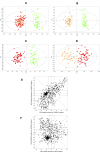Serum metabolomic profiling facilitates the non-invasive identification of metabolic biomarkers associated with the onset and progression of non-small cell lung cancer
- PMID: 26883203
- PMCID: PMC4914330
- DOI: 10.18632/oncotarget.7354
Serum metabolomic profiling facilitates the non-invasive identification of metabolic biomarkers associated with the onset and progression of non-small cell lung cancer
Abstract
Lung cancer (LC) is responsible for most cancer deaths. One of the main factors contributing to the lethality of this disease is the fact that a large proportion of patients are diagnosed at advanced stages when a clinical intervention is unlikely to succeed. In this study, we evaluated the potential of metabolomics by 1H-NMR to facilitate the identification of accurate and reliable biomarkers to support the early diagnosis and prognosis of non-small cell lung cancer (NSCLC).We found that the metabolic profile of NSCLC patients, compared with healthy individuals, is characterized by statistically significant changes in the concentration of 18 metabolites representing different amino acids, organic acids and alcohols, as well as different lipids and molecules involved in lipid metabolism. Furthermore, the analysis of the differences between the metabolic profiles of NSCLC patients at different stages of the disease revealed the existence of 17 metabolites involved in metabolic changes associated with disease progression.Our results underscore the potential of metabolomics profiling to uncover pathophysiological mechanisms that could be useful to objectively discriminate NSCLC patients from healthy individuals, as well as between different stages of the disease.
Keywords: NSCLC; biomarkers; early diagnosis; metabolomics; prognosis.
Conflict of interest statement
The authors declare no conflict of interest.
Figures

 ) vs. NSCLC patients (early-stage and advanced-stage,
) vs. NSCLC patients (early-stage and advanced-stage,  and
and  , respectively); B. healthy individuals (
, respectively); B. healthy individuals ( ) vs. early-stage NSCLC patients (
) vs. early-stage NSCLC patients ( ); C. healthy individuals (
); C. healthy individuals ( ) vs. advanced-stage NSCLC patients (
) vs. advanced-stage NSCLC patients ( ) and D. early-stage NSCLC patients (
) and D. early-stage NSCLC patients ( ) vs. advanced-stage NSCLC patients (
) vs. advanced-stage NSCLC patients ( ). SUS-plots derived from the OPLS-DA models between: E. healthy individuals vs. early-stage NSCLC patients (model B, horizontal axis) and healthy individuals vs. advanced-stage NSCLC patients (model C, vertical axis); F. healthy individuals vs. NSCLC patients (model A, horizontal axis) and early-stage NSCLC vs. advanced-stage NSCLC patients (model D, vertical axis). Rectangles indicate unique biomarkers for each model.
). SUS-plots derived from the OPLS-DA models between: E. healthy individuals vs. early-stage NSCLC patients (model B, horizontal axis) and healthy individuals vs. advanced-stage NSCLC patients (model C, vertical axis); F. healthy individuals vs. NSCLC patients (model A, horizontal axis) and early-stage NSCLC vs. advanced-stage NSCLC patients (model D, vertical axis). Rectangles indicate unique biomarkers for each model.
 : healthy individuals -validation set-;
: healthy individuals -validation set-;  : NSCLC patients -validation set-;
: NSCLC patients -validation set-;  : BPD patients -validation set-;
: BPD patients -validation set-;  : healthy individuals -training set-;
: healthy individuals -training set-;  : NSCLC patients -training set-). C. Misclassification table based on the logistic regression equation. D. Boxplot (log scale) representing the intensities of the metabolites included in the logistic regression equation for the different groups. For each box, the central line is the median, the edges of the box are the upper and lower quartiles, the whiskers extend the box by a further ±1.5 interquartile range (IQR), and outliers are plotted as individual points.
: NSCLC patients -training set-). C. Misclassification table based on the logistic regression equation. D. Boxplot (log scale) representing the intensities of the metabolites included in the logistic regression equation for the different groups. For each box, the central line is the median, the edges of the box are the upper and lower quartiles, the whiskers extend the box by a further ±1.5 interquartile range (IQR), and outliers are plotted as individual points.References
-
- Ferlay J, Soerjomataram I, Dikshit R, Eser S, Mathers C, Rebelo M, Parkin DM, Forman D, Bray F. Cancer incidence and mortality worldwide: sources, methods and major patterns in GLOBOCAN 2012. International journal of cancer. 2015;136:E359–386. - PubMed
-
- Goldstraw P, Crowley J, Chansky K, Giroux DJ, Groome PA, Rami-Porta R, Postmus PE, Rusch V, Sobin L, International Association for the Study of Lung Cancer International Staging C Participating I The IASLC Lung Cancer Staging Project: proposals for the revision of the TNM stage groupings in the forthcoming (seventh) edition of the TNM Classification of malignant tumours. Journal of thoracic oncology. 2007;2:706–714. - PubMed
-
- Holmes E, Wilson ID, Nicholson JK. Metabolic phenotyping in health and disease. Cell. 2008;134:714–717. - PubMed
MeSH terms
Substances
LinkOut - more resources
Full Text Sources
Other Literature Sources
Medical

